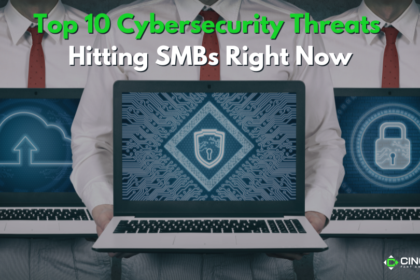
SMB cybersecurity has become a critical issue as cybercriminals increasingly turn their attention toward smaller organizations. While many owners still assume attackers mainly target large corporations, the reality is that today’s threat landscape places small and mid-sized companies directly in the crosshairs.
Strengthening SMB cybersecurity starts with understanding the top threats and where your organization may be vulnerable. By proactively identifying weaknesses and shoring up critical defenses, SMBs can stay ahead of evolving threats and avoid the costly fallout of an attack.
____________________________________________________________________________
Why Small Businesses Are Prime Targets for Cyberattacks
Why? Attackers assume SMBs have weaker defenses. Cyber threats aren’t just an enterprise problem. Across the country, these risks are growing quickly as attackers deploy more advanced phishing campaigns, ransomware, password attacks, and social engineering schemes designed specifically for SMBs. The consequences can be devastating: downtime, data loss, financial theft, and lasting reputational damage.
Many of today’s attacks specifically target small and mid-sized businesses. Smaller companies are increasingly in the crosshairs, with Verizon reporting that 43% of cyber attacks target small businesses.
Here are the top 10 cybersecurity threats hitting SMBs right now, and why they’re so dangerous:
- Phishing Attacks: Phishing – fraudulent emails or messages impersonating trusted entities – remains the #1 threat. Scammers trick employees into clicking malicious links or giving up passwords. Phishing plays a major role in today’s data breaches. In fact, business email compromise and phishing together make up 60% of all cyber insurance claims. Just one mistaken click can unleash malware or expose sensitive financial information. That’s why ongoing employee training and strong email filtering tools are essential to reducing this constant threat.
- Ransomware: Ransomware is still rampant, and SMBs are prime targets. This malware encrypts your files and demands payment (ransom) for the decryption key. It can completely paralyze a business. According to a 2025 report, 88% of SMB cybersecurity breaches now involve ransomware – a 37% jump from last year. Attackers have honed in on smaller organizations with limited security. Ransom demands can reach six or seven figures, though the average payment is often lower (Coveware noted a $110,000 median payment in late 2024). The best defense is a multi-layered one: strong perimeter security, up-to-date systems, and reliable offsite backups so you can recover without paying.
- Insider Threats (and Human Error): Not all threats come from outside. Insider threats include rogue employees stealing data or unintentional errors by staff that create security gaps. For example, an employee might mishandle sensitive data or click a phishing link that lets an attacker in. Small businesses often have high trust environments, which attackers exploit. Whether malicious or accidental, insiders can cause breaches. Limiting user access (least privilege) and monitoring unusual internal behavior can mitigate this.
- Weak or Stolen Passwords: Poor password practices are a major security hole. Attackers use techniques like credential stuffing – trying leaked passwords en masse – to break into accounts. Over 80% of hacking-related breaches involve compromised passwords (according to Verizon DBIR data). SMBs are particularly at risk if they don’t enforce strong passwords and multi-factor authentication. A leaked password from one site could let attackers into your Office 365 or QuickBooks if reused. Implementing a password manager and MFA on all accounts is critical to counter this threat.
- Unpatched Software Vulnerabilities: Cybercriminals constantly scan for servers, software, or devices with known vulnerabilities that haven’t been patched. SMBs often lag on updates, which is risky. Attacks on known (unpatched) vulnerabilities surged by 54% in 2024. Examples include last year’s Microsoft Exchange and Log4j flaws, which hackers widely exploited when businesses delayed patching. Every month, dozens of security fixes are released by vendors. Failing to apply them is like leaving holes in your digital walls. Establish prompt patch management to close these doors.
- Business Email Compromise (BEC): BEC is a form of phishing where attackers impersonate a company executive or vendor via email to trick someone (often in accounting) into sending money or gift cards. For instance, a fraudster might spoof your CEO’s email and request an urgent wire transfer. Funds transfer fraud stemming from BEC has caused losses averaging $185,000. SMBs in cities such as Denver have lost tens of thousands in these scams. To avoid this, always verify unusual payment requests through a secondary channel (call the person, etc.) before acting.
- Malware (Viruses/Trojans): General malware – beyond ransomware – continues to plague small businesses. This includes spyware that steals data, banking Trojans that siphon money, or worms that spread across networks. Malware is the most common attack type on SMBs (18% of attacks). Infections can come via email attachments, malicious downloads, or USB drives. Modern endpoint security software and user caution are key here.
- Distributed Denial-of-Service (DDoS) Attacks: DDoS attacks flood your website or network with traffic to knock it offline. While more commonly aimed at larger entities, SMB websites (especially e-commerce or frequently visited sites) can be targeted, sometimes as extortion (attacker demands payment to stop the flood). A sustained DDoS can disrupt your customer-facing services. Cloud-based DDoS protection services or your web host’s anti-DDoS measures can help absorb the traffic. It’s a lower probability threat for most SMBs but worth noting if your business relies heavily on an online presence.
- Third-Party and Supply Chain Attacks: Many small businesses use third-party software or IT service providers. If those get breached, you can be indirectly compromised (as seen in the Kaseya and SolarWinds incidents). Coalition Insurance found 52% of cyber claims involved a third-party breach. With some attackers targeting a smaller company as a stepping stone to a bigger partner or client (supply chain attack). Manage this by vetting vendors’ security and using least privilege for integrations – e.g., don’t give a bookkeeping software full admin access to all data if not necessary.
- IoT and Remote Work Risks: With more remote work and “Internet of Things” (IoT) devices, new threats emerge. Home office networks are usually less secure, and a simple compromised home Wi-Fi or personal device can lead into company systems. IoT devices from workers homes aren’t the only potential issue. Devices like smart cameras or thermostats in your office could be entry points if not secured. A great example of this is the famous case of hackers entering a casino’s network via a smart fish tank thermometer. Use VPNs for remote workers, ensure endpoint protection on home PCs that access work, and isolate IoT gadgets on a separate network.

Top 10 SMB Cybersecurity
What to Do
Facing these threats can be daunting, but there are proactive steps to manage the risk:
- First, educate your team- a strong security culture can curb phishing, BEC, and insider errors significantly.
- Second, implement key protections- MFA (Multi factor authentication) on accounts, good backups, updated systems, and next-gen firewall/endpoint security.
- Third, consider hiring a local managed IT services provider- Many SMBs have also turned to professional help. Partnering with a provider for managed cybersecurity Companies will act like insurance and maintenance all in one for your company. Companies who don’t partner with an MSP face a higher risk of costly downtime and data loss. Given the data – e.g., employees at small firms face 350% more social engineering attacks than those at larger companies – taking action is urgent.
With Cinch IT you get the peace of mind that professionals are watching over your tech. You can get started with a free IT security assessment to identify weaknesses.
__________________________________________________________________
Summary
By staying vigilant against these top 10 threats and shoring up defenses, your business can significantly reduce the likelihood of a cyber incident. It’s about covering the basics (patches, passwords, backups) and staying alert to new scams. The threat landscape is always evolving, but focusing on these prevalent dangers will put you miles ahead.
Remember, even though attackers cast eyes on small businesses, you are not defenseless. By taking simple measures like enabling MFA or training staff, you can thwart the majority of attacks.
____________________________________________________________________
FAQ: How to Protect Your SMB Cybersecurity
Q: Why is SMB cybersecurity so important right now?
A: Attackers increasingly view SMBs as easier targets because they often lack the tools and processes larger companies use. Strong small business cybersecurity or partnering with a local MSP reduces your risk of ransomware, phishing, and financial fraud.
Q: What are the biggest cybersecurity threats facing small businesses?
A: The most common threats include phishing attacks, ransomware, weak passwords, unpatched systems, and business email compromise. All of these are preventable with proper small business cybersecurity planning.
Q: How can a small business improve cybersecurity without a big budget?
A: Start with essentials: MFA (multi-factor authentication), regular updates, employee training, strong backups, and a trusted managed IT provider. These steps dramatically strengthen SMB cybersecurity for minimal cost.
____________________________________________________________________________
About the Author
Niko Zivanovich is a Cybersecurity Leader with experience in helping organizations understand and achieve a more complete security posture. He is a co-owner of Cinch IT of Denver and has been working at Pellera Technology Solutions for 6 years, most recently as the Director of Cyber Defense and Threat Intelligence. Niko specializes in CISO advising, netsec ops, incident response, pen testing, and threat intelligence research. He holds multiple certifications through the SANS GIAC organization and is a Board Director for the InfraGard Colorado and Wyoming Chapter.
Enjoy the Top 10 SMB Cybersecurity Threats Hitting SMBs Right Now article? If so then head over to our Blogs for more top tech tips.
____________________________________________________________________________
About Cinch I.T.
Founded on the belief that I.T. support should be easy, Cinch I.T. has grown into one of the nation’s fastest-growing managed service providers. Our franchise model blends centralized expertise with local ownership, giving clients the best of both worlds. Our team is committed to being more than just a service provider, we’re your dedicated partner in achieving operational efficiency and peace of mind. With our fast, friendly, and transparent approach, you’ll always know where you stand.
Discover how Cinch IT can support your success through smarter, more secure technology solutions. Contact us today!
View our nationwide Cinch I.T. offices:
Sources
These insights come from industry reports and incident data. Verizon’s annual report highlights how phishing and credential theft dominate breach causes. Insurance analyses by companies like Coalition show the heavy role of BEC and ransomware in SMB losses. Meanwhile, cybersecurity researchers (NordLayer, Cynet, etc.) consistently list phishing, malware, and insider error among top SMB cybersecurity threats. By understanding the most common attack vectors, you can prioritize defenses and keep your Denver business out of those unfortunate statistics.



